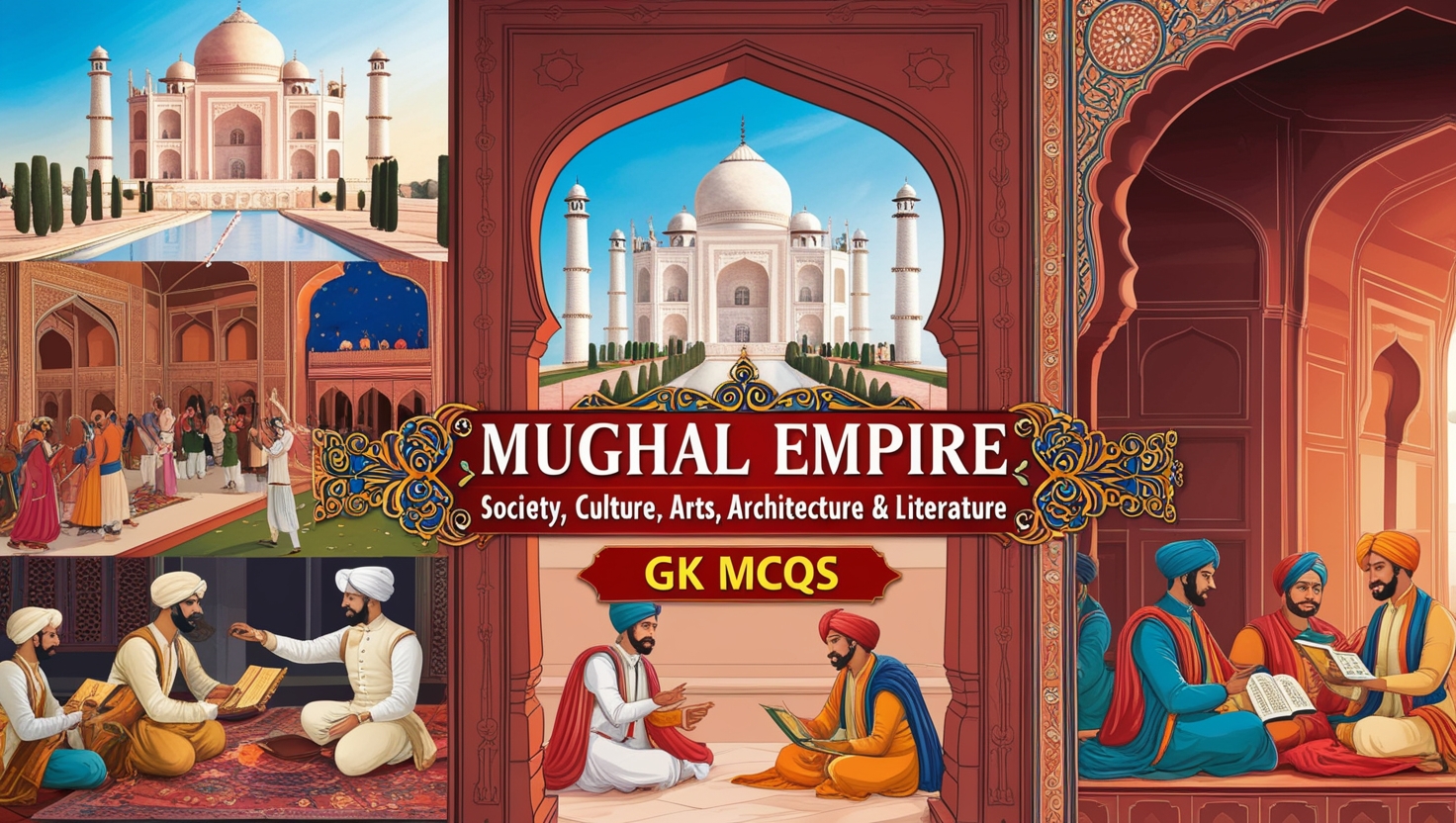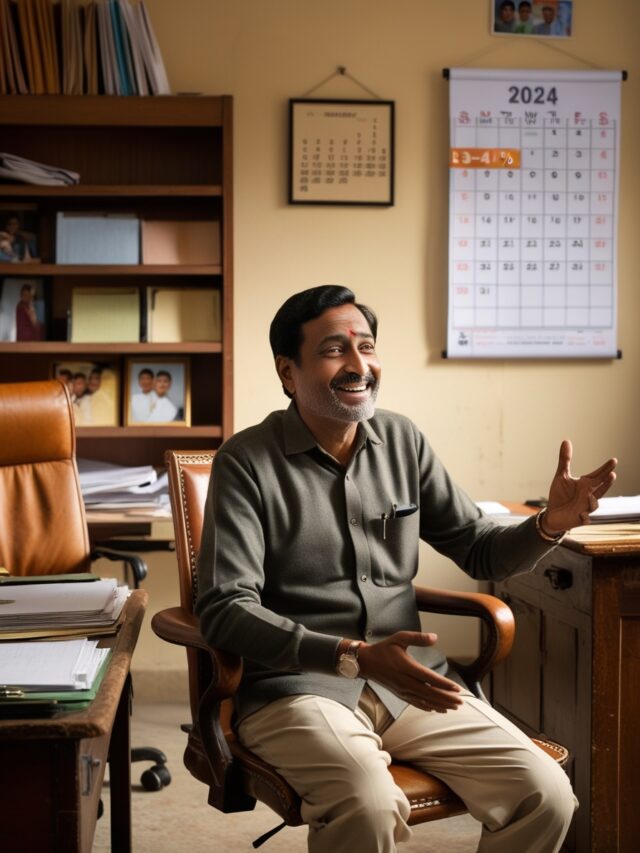
1. Which of the following ladies wrote a historical account during the Mughal period?
- Gulbadan Begum
- Noorjahan Begum
- Jahanara Begum
- Zebun-nissah Begum
Show Answer
Answer: Gulbadan Begum
Gulbadan Begum, born in 1523, was a Persian-Turkic princess and the daughter of Emperor Babur. She is renowned as the author of the Humayun-Nama, which is an account of the life of her half-brother, Emperor Humayun. Her work provides valuable historical insights into the Mughal Empire during the 16th century.
2. Baburnama was written in which language?
- Para-Mongolic
- Chagatai Turkic
- Hijazi Arabic
- Bahrani Arabic
Show Answer
Answer: Chagatai Turkic
The Baburnama, also known as Tuzk-e Babri, was written by Babur, the founder of the Mughal Empire, in Chagatai Turkic. This autobiography is historically significant as it’s considered the first true autobiography in the Islamic literary tradition, providing a detailed account of Babur’s life and the early years of the Mughal Empire.
3. Which among the following buildings built by Shah Jahan at Agra is similar in pattern to the Saint Basil’s Cathedral in Moscow?
- Taj Mahal
- Agra fort
- Moti Masjid
- Shah Jahani Mahal
Show Answer
Answer: Moti Masjid
The Pearl Mosque, or Moti Masjid, is a mosque located in Agra. It was constructed by Shah Jahan, the Mughal emperor famous for building the Taj Mahal. The architectural style of the Moti Masjid has some similarities to the Saint Basil’s Cathedral in Moscow, showcasing exquisite Mughal architecture.
4. Akbarnama was originally written in which language?
- Chagatai Turkic
- Persian
- Arabic
- Urdu
Show Answer
Answer: Persian
Abul Fazal, a prominent scholar in the Mughal court, authored the Akbarnama, a historical work written in Persian. This significant text serves as the official history of Emperor Akbar’s reign, offering a detailed account of his ancestors and his own rule.
5. Who among the following poets used to write Urdu Ghazals with the pen name “Asad”?
- Mir Taqi Mir
- Dushyant
- Mirza Ghalib aka Mirza Asadullah Beg Khan
- Amir Khusrow
Show Answer
Answer: Mirza Ghalib aka Mirza Asadullah Beg Khan
Mirza Ghalib, originally known as “Mirza Asadullah Baig Khan,” was a celebrated Urdu poet and a notable figure in the Mughal court. He adopted the pen name “Ghalib” and left a remarkable legacy with his profound and intricate poetry.
6. Who among the following laid the foundation of Shalimar & Nishaat Garden in Kashmir?
- Akbar
- Jahangir
- Shahjahan
- Nur Jahan
Show Answer
Answer: Jahangir
Jahangir, a Mughal emperor, laid the foundation of the Shalimar and Nishat Gardens in Kashmir. The Nishat Bagh is a stunning terraced Mughal garden situated on the eastern side of the Dal Lake, near Srinagar in Jammu and Kashmir, India. These gardens are admired for their captivating design and scenic beauty.
7. Which among the following Mughal painters is credited for painting Siberian Crane and the Dodo for the first time?
- Abu al-Hasan
- Bishandas
- Farrukh Beg
- Ustad Mansur
Show Answer
Answer: Ustad Mansur
Ustad Mansur, a renowned painter in Emperor Jahangir’s court, was known for his exquisite depictions of plants and animals. His works, such as paintings of the Siberian Crane and the Dodo, played a crucial role in zoological studies and are regarded as valuable historical references.
8. ‘Padshah-nama’ (Chronicle of the Emperor) written by Abdul Hamid Lahori, is the official visual history giving a detailed account of the reign of which of the following Mughal Emperors?
- Babur
- Jahangir
- Shah Jahan
- Aurangzeb
Show Answer
Answer: Shah Jahan
Padshahnama, or Badshah Nama, belongs to a genre of works written as the official history of the Mughal Emperor Shah Jahan’s reign. These texts offer insights into the events, achievements, and historical context of Shah Jahan’s rule.
9. Ustad Isa is related to the design and architecture of which of the following Buildings in the Mughal Era?
- Taj Mahal
- Buland Darwaza
- Red Fort
- Itimad-ud-daula’s tomb
Show Answer
Answer: Taj Mahal
Ustad Isa was the chief architect responsible for the design and construction of the Taj Mahal, one of the most iconic architectural masterpieces in the world. His exceptional skills and vision contributed to the creation of this UNESCO World Heritage site.
10. Sur Sagar,” a treatise on music, was written during the reign of which of the following Mughal emperors?
- Humayun
- Akbar
- Jahangir
- Shah Jahan
Show Answer
Answer: Akbar
Surdas, a revered poet and musician, is known for composing the Sursagar. Although Surdas lived during the reign of Akbar, he primarily composed devotional songs and poetry in praise of Lord Krishna. His contemporary Tulsidas, famous for writing the Ramcharitmanas, also significantly influenced devotional literature during this period.
Q11: Who wrote Humayun Nama during the Mughal period?
1. Humayun
2. Khwand Amir
3. Gulbadan Begum
4. Abu Fazal
Show Answer
Answer: 3
Explanation: Gulbadan Begum, a Mughal princess and the daughter of Emperor Babur, is known as the author of Humayun-Nama, an account of the life of her half-brother, Emperor Humayun, which she wrote on the request of her nephew, Emperor Akbar.
Q12: During the reign of Akbar, Who translated Mahabharata as Razmnama?
1. Humayun
2. Khwand Amir
3. Faizi and `Abd al-Qadir Bada’uni
4. Abu Fazal
Show Answer
Answer: 3
Explanation: The Mahabharata was translated into Persian at the orders of Emperor Akbar by scholars Faizi and `Abd al-Qadir Bada’uni. This translated version, known as the Razmnama, played a crucial role in the cross-cultural exchange of literature during the Mughal Renaissance.
Q13: Moti Masjid was built in the Red Fort by which of the following Mughal Emperors?
1. Shah Jahan
2. Aurangzeb
3. Shah Aalam II
4. Akbar
Show Answer
Answer: 2
Explanation: Moti Masjid is indeed a mosque located within the Red Fort in Delhi. It was built by Emperor Aurangzeb in 1659 for his second wife and was primarily used by the ladies of the Zenana, the female quarters of the royal court.
Q14: The Fort of Allahabad was built by which Mughal Emperor?
1. Akbar
2. Shershah Suri
3. Humayun
4. Babur
Show Answer
Answer: 1
Explanation: The Fort of Allahabad is a significant historical monument, and it is the largest fort built by Emperor Akbar. Constructed in 1583 on the banks of the Yamuna River, it remains a popular tourist attraction in Allahabad due to its historical and architectural importance.
Q15: Out of the Capital of Akbar’s Kingdom, Buland Darwaza, Panch Mahal, and Akbar’s Mausoleum, which are located at the same place?
1. Panch Mahal and Akbar’s Mausoleum
2. Buland Darwaza, Panch Mahal, and Akbar’s Mausoleum
3. Capital of Akbar’s Kingdom, Buland Darwaza, Panch Mahal
4. Capital of Akbar’s Kingdom and Akbar’s Mausoleum
Show Answer
Answer: 3
Explanation: During Akbar’s rule, Fatehpur Sikri was the capital of his kingdom. The Buland Darwaza, a grand gateway, and the Panch Mahal, a five-story palace, are located in Fatehpur Sikri. On the other hand, Akbar’s Mausoleum is located in Sikandara and serves as the final resting place of the great Mughal emperor. These sites are renowned for their historical significance and architectural splendor.
Q16: Who built the tomb of Itimad-Ud-Daula?
1. Jahangir
2. Nur Jahan
3. Shershah
4. Akbar
Show Answer
Answer: 2
Explanation: The Tomb of Itimad-Ud-Daula, often referred to as the Baby Taj, was indeed constructed by Mughal queen Nur Jahan. This elegant mausoleum is located in Agra and was built between 1622 and 1628. Its purpose was to serve as the final resting place of her father, Mirza Ghiyas Beg, who held the title Itimad Ud Daula. The tomb is renowned for its intricate and delicate marble inlay work, setting it apart as a masterpiece of Mughal architecture.
Q17: In which fort is Jahangir Mahal located?
1. Lahore Fort
2. Agra Fort
3. Red Fort
4. Golconda Fort
Show Answer
Answer: 2
Explanation: Jahangir Mahal is situated within the Agra Fort and was built by Emperor Akbar, not Jahangir. This imposing structure stands as an exemplary work of Mughal architecture. It was designed in a combination of Persian and Rajput architectural styles and served as the residence for the Rajput wives of Akbar, highlighting the fusion of different cultural influences during the Mughal era.
Q18: Who translated Baburnama from Chagatai to Persian?
1. Abdul Rahim Khan-I-Khana
2. Abul Fazal
3. Khawaja Reazuddin Atash
4. Humayun
Show Answer
Answer: 1
Explanation: Baburnama, written by the first Mughal emperor Babur, was indeed composed in Chagatai Turkic. Abdul Rahim Khan-I-Khana, the son of Bairam Khan, played a significant role by translating this work into Persian, making it accessible to a broader audience and contributing to its preservation and dissemination.
Q19: Who wrote the book Majma-ul-Bahrain?
1. Aurangzeb
2. Akbar
3. Dara Shukoh
4. Abu Fazal
Show Answer
Answer: 3
Explanation: Majma-ul-Bahrain is an intriguing book on comparative religion authored by Dara Shukoh, the eldest son of Emperor Shah Jahan. This work delves into the mystical and pluralistic connections between Sufi and Vedanta philosophies, reflecting Dara Shukoh’s deep interest in spirituality and interfaith dialogue.
Q20: During Akbar’s reign, who translated Atharva Veda into Persian?
1. Haji Ibrahim Sarhindi
2. Abdul Qadir Badayuni
3. Naqib Khan
4. None of the above
Show Answer
Answer: 1
Explanation: Haji Ibrahim Sarhindi, a scholar in Akbar’s court, is credited with translating the Atharva Veda into Persian. This translation played a role in facilitating the cross-cultural exchange of knowledge and ideas during the Mughal period.
Q21: Who changed the name of Tanna Mishra to Tansen among the following options?
1. Akbar
2. Raja Vikramjit of Gwalior
3. Raja Mansingh Tomar
4. Swami Haridas
Show Answer
Answer: 2
Explanation: Raja Vikramjit of Gwalior, who belonged to the Tomaras of Gwalior dynasty, is said to have changed the name of Tanna Mishra to Tansen. The Tomara dynasty was indeed known for its patronage of cultural activities in Gwalior during the 14th to 16th centuries, and Tansen emerged as one of their most celebrated musicians and composers.
Q22: Which Mughal Emperor was a contemporary of Mirza Ghalib?
1. Alamgir II
2. Muhammad Shah
3. Bahadur Shah Zafar
4. Farrukhsiyar
Show Answer
Answer: 3
Explanation: Mirza Ghalib was indeed a prominent Urdu and Persian poet who lived during the final years of the Mughal Empire. He is often considered one of the most significant poets in the Urdu language and was a contemporary of Bahadur Shah Zafar, the last Mughal emperor.
Q23: According to Abul Fazl’s records, which musical instrument did Akbar play?
1. Dholak
2. Tabla
3. Nakkara
4. Mridang
Show Answer
Answer: 3
Explanation: Akbar, the great Mughal king, was known for his multifaceted interests, and playing the Nakkara (a type of kettle drum) was one of his recorded pursuits. His deep appreciation for music and the arts was reflected in his patronage of musicians and artists at his court.
Q24: What are the characteristics of Mughal Architecture in India?
1. Bulbous domes with constricted necks
2. Use of Red Sandstone
3. Mausoleums outnumbering the mosques
4. All of the above
Show Answer
Answer: 4
Explanation: Mughal architecture in India is characterized by several distinctive features, including bulbous domes with constricted necks, the extensive use of red sandstone, and an abundance of mausoleums compared to mosques. These architectural elements are evident in many iconic Mughal structures, such as the Taj Mahal and the Red Fort.
Q25: Which of the following monuments are located in India?
1. Akbar’s tomb
2. Babur’s tomb
3. Jahangir’s Tomb
4. All of the above except B
Show Answer
Answer: 4
Explanation: Akbar’s tomb is situated at Sikandra, near Agra, while Babur’s tomb is located in Kabul, Afghanistan. Jahangir’s Tomb is in Shahdara, a suburb of Lahore, Pakistan. These tombs are significant historical and architectural landmarks, each reflecting the unique characteristics of the respective Mughal emperor.
Q26: What are the features of a congregational mosque?
1. Sahn (courtyard)
2. Minaret
3. Both Sahn and Minaret
4. None of the above
Show Answer
Answer: 3
Explanation: A congregational mosque is characterized by both a Sahn (a courtyard) and a Minaret (a tower attached to the mosque). This type of mosque design facilitates the congregation’s activities and provides a distinct architectural identity.
Q27: When was the Ibadat Khana at Fatehpur Sikri constructed?
1. 1525 CE
2. 1575 CE
3. 1550 CE
4. 1570 CE
Show Answer
Answer: 2
Explanation: In recognition of his reverence for Sufi saint Salim Chishti, Akbar constructed the Ibadat Khana, or Hall of Prayers, at his new capital, Fatehpur Sikri, in 1575 CE. This building served as a place for religious discussions, and Akbar invited learned scholars from various religions to foster interfaith dialogue and understanding.
Q28: Who were the followers of the new religion introduced by Akbar called Din-i-llahi?
1. Birbal
2. Abul Fazal
3. Abul Faizi
4. All of the above
Show Answer
Answer: 4
Explanation: Akbar did promote a syncretic religious philosophy known as Din-i-llahi or Tauhid-i-Ilahi (Divine Monotheism) around 1582 CE. This belief system emphasized the oneness of God and peace among diverse religious communities. Some of his followers, such as Birbal, Abul Fazal, and Abul Faizi, adhered to these teachings during his lifetime.
Q29: Who were present in Akbar’s Navratnas (nine jewels)?
1. Abul Fazl
2. Kabir
3. Fakir Aziao Din
4. All of the above
Show Answer
Answer: 4
Explanation: Akbar’s court included nine eminent courtiers, collectively known as Akbar’s Navratnas (Nine Jewels). These individuals were celebrated for their contributions to various fields, including art, literature, administration, and more. Among the notable Navratnas were Abul Fazl, Kabir, and Fakir Aziao Din, each contributing significantly to the flourishing cultural and intellectual environment during Akbar’s rule.
Q30: Who wrote Ain-i-Akbari and Akbar Nama?
1. Abul Fazl
2. Abul Faizi
3. Fakir Aziao Din
4. None of the above
Show Answer
Answer: 1
Explanation: Abu’l-Fazl ibn Mubarak, commonly known as Abul Fazl, was indeed the Grand Vizier of the Mughal emperor Akbar. He was a prominent figure in Akbar’s court and was not only a key advisor but also a prolific writer. Abul Fazl authored two significant works, the Akbarnama, which is a comprehensive and official historical account of Akbar’s reign in three volumes, and the Ain-i-Akbari, a document that provides detailed insights into the administration, culture, and society of Akbar’s empire. He played a vital role in Akbar’s policy of religious tolerance and Sulh-i-Kul, aiming for universal peace and harmony.
Q31: Abul Fazl was murdered by which ruler?
1. Bir Singh Bundela
2. Amar Singh
3. Maharana Pratap
4. None of the above
Show Answer
Answer: 1
Explanation: Abul Fazl, one of Akbar’s Navratnas (Nine Jewels), was indeed a pivotal advisor and writer in the Mughal court. Unfortunately, his life was cut short when he was assassinated by Bir Singh Bundela. This event marked the tragic end of a remarkable individual who had significantly contributed to Akbar’s court and legacy.
Q32: Which poet translated Lilavati into Persian?
1. Abul Fazl
2. Abul Faizi
3. Fakir Aziao Din
4. Tansen
Show Answer
Answer: 2
Explanation: Abul Faizi, the brother of Abul Fazl, was a renowned Persian poet who translated Lilavati, a work on mathematics, into Persian. He also played a crucial role in overseeing the translation of the Mahabharata into Persian. This translation work contributed to the dissemination of Indian literature and knowledge.
Q33: Under whose supervision was the Mahabharata translated into the Persian language?
1. Abul Faizi
2. Fakir Aziao Din
3. Abul Fazl
4. Birbal
Show Answer
Answer: 1
Explanation: Shaikh Abu al-Faiz ibn Mubarak, popularly known as Faizi, was one of Akbar’s Navratnas and supervised the translation of the Mahabharata into the Persian language.
Q34: Who was the Sufi mystic in Akbar’s Navratnas?
1. Abul Faizi
2. Salim Chisti
3. Abul Fazl
4. Fakir Aziao Din
Show Answer
Answer: 4
Explanation: Fakir Aziao Din was a Sufi mystic and one of Akbar’s Navratnas. His role as a chief advisor to Akbar highlights the emperor’s interest in integrating spiritual and mystical perspectives into his administration. Fakir Aziao Din’s presence in the court symbolized Akbar’s commitment to harmonizing diverse influences.
Q35: Tansen accepted Islam at the hand of which great Sufi Saint?
1. Salim Chishti
2. Sheikh Muinuddin Chisti
3. Qutbuddin Bakhtiar Kaki
4. Muhammad Ghaus
Show Answer
Answer: 4
Explanation: Tansen, the celebrated musician from Gwalior, is traditionally believed to have accepted Islam at the hands of the Sufi mystic saint Muhammad Ghaus of Gwalior. This event underscores the interplay of diverse religious influences within the Mughal Empire, showcasing an example of conversion during this period.
Q36: Who translated the Babarnama into Turki?
1. Abdul Rahim Khan-i-Khanan
2. Abul Fazl
3. Mirza Aziz Koka
4. Fakir Aziao Din
Show Answer
Answer: 1
Explanation: Abdul Rahim Khan-i-Khanan, the son of Bairam Khan, was a renowned poet in the Mughal court. He is credited with translating the Babarnama into Turki, which was Babur’s memoir. His contributions enriched the literary landscape during the Mughal era.
Q37: Which of the following statements are correct regarding social life in the Mughal empire?
1. The Mughal society was stratified primarily into three sections – upper, middle, and lower.
2. The nobility played a major role in assisting the ruler in implementing state policies.
3. The life of the nobles was opulent and luxurious, comprising the affluent section of society.
4. All of the above
Show Answer
Answer: 4
Explanation: The Mughal society was indeed structured into three main sections: the upper, middle, and lower classes. The nobility, comprising the upper class, played a pivotal role in assisting the ruler and implementing state policies. The nobles enjoyed a luxurious lifestyle, which set them apart as the affluent section of society.
Q38: Which of the following statements is/are correct regarding social hierarchy in the Mughal empire?
1. The middle class in the Mughal empire was a heterogeneous group of well-off merchants, professionals, and petty mansabdars.
2. The lower classes of Mughal society comprised of cultivators, artisans, small traders, shopkeepers, household servants, and slaves.
3. Both 1 & 2
4. Neither 1 & 2
Show Answer
Answer: 3
Explanation: The middle class in the Mughal Empire was a diverse group consisting of well-off merchants, professionals, and petty mansabdars (government officials holding military ranks). In contrast, the lower classes included cultivators, artisans, small traders, shopkeepers, household servants, and slaves. This social stratification characterized the Mughal society and reflected varying economic and social roles.
Q39: Which of the following statements are correct regarding the status of women in the Mughal empire?
1. Women generally occupied a subordinate position in Mughal society.
2. Social practices such as purdah, polygamy, female infanticide, and sati were not prevalent.
3. Polygamy was common among Muslims.
4. All of the above
Show Answer
Answer: 4
Explanation: All three statements are correct regarding the status of women in the Mughal empire. Women generally held a subordinate position in society, and social practices like purdah (seclusion of women), polygamy (having multiple wives), female infanticide (killing newborn girls), and sati (widow self-immolation) were not prevalent. Polygamy was indeed common among Muslims during that period.
Q40: Which of the following promulgated Mahzar, through which the King delegated to himself the powers to interpret various Islamic norms?
1. Akbar
2. Shah Jahan
3. Jahangir
4. Aurangzeb
Show Answer
Answer: 1
Explanation: The promulgation of Mahzar by the Mughal Emperor Akbar was a significant development in the realm of religious policy. Through this decree, Akbar assumed the authority to interpret various Islamic norms, which were previously the prerogative of the ulema, the Islamic scholars. This move allowed him to introduce a policy of religious tolerance and accommodation, known as Sulh-i-Kul or peace to all. Akbar sought to foster harmony among people of different faiths, aiming to create an inclusive and tolerant empire. His approach was characterized by a willingness to engage with various religious traditions, leading to a period of cultural and religious synthesis.
Q41: The Badshahi Mosque in Lahore was built by which Mughal Emperor?
1. Akbar
2. Jahangir
3. Shah Jahan
4. Aurangzeb
Show Answer
Answer: 4
Explanation: The Badshahi Mosque, located in Lahore, Pakistan, is indeed one of the grandest examples of Mughal architecture. Commissioned by the Mughal Emperor Aurangzeb, it was constructed between 1671 and 1673. The mosque is renowned for its architectural splendor and is considered one of the largest mosques globally. Its design features distinctive Mughal elements and reflects the Mughal empire’s architectural grandeur.
Q42: Which of the following introduced the Persian style of architecture to India by building many structures at Agra, Biana, Dholpur, Gwalior, and Kiul?
1. Babur
2. Humayun
3. Akbar
4. Shah Jahan
Show Answer
Answer: 1
Explanation: The founder of the Mughal Empire, Babur, indeed introduced the Persian style of architecture to the Indian subcontinent. Babur constructed several structures at various places, including Agra, Biana, Dholpur, Gwalior, and Kiul (Aligarh). While many of these structures have not survived over the centuries, they played a crucial role in laying the foundation for Mughal architectural traditions in India. The Persian influence, combined with local architectural elements, created a unique Mughal architectural style.
Q43: Which of the following built Akbar’s mausoleum at Sikandra?
1. Shah Jahan
2. Jahangir
3. Aurangzeb
4. None of the above
Show Answer
Answer: 2
Explanation: The Mughal Emperor Jahangir is attributed to the construction of Akbar’s mausoleum at Sikandra, which is located near Agra. He also built the tomb of Itimad-ud-Daula, his father-in-law, in Agra. These structures are significant examples of Mughal architecture and display a fusion of Persian and Indian design elements.
Q44: Which of the following was called the engineer king and the prince of builders?
1. Humayun
2. Akbar
3. Jahangir
4. Shah Jahan
Show Answer
Answer: 4
Explanation: The Mughal Emperor Shah Jahan, often referred to as the engineer king and the prince of builders, was renowned for his keen interest in architectural planning. He played a pivotal role in constructing several iconic Mughal monuments, including the Taj Mahal in Agra and the Red Fort in Delhi. His architectural legacy left a profound mark on Mughal architecture and the cultural heritage of India.
Q45: Which of the following buildings of the Mughal era is mentioned as rauza-i munawwara in contemporary books?
1. Red Fort, Agra
2. Red Fort, Delhi
3. Taj Mahal
4. Jama Masjid, Delhi
Show Answer
Answer: 3
Explanation: The Taj Mahal, a magnificent Mughal monument located in Agra, is often referred to as rauza-i munawwara in contemporary literature. This Persian term translates to the illumined or illustrious tomb, signifying the grandeur and splendor of the Taj Mahal. It is considered one of the most famous examples of Mughal architecture, known for its white marble structure, intricate design, and its status as a UNESCO World Heritage Site.
Q46: Which of the following is the most recent example of Mughal Architecture?
1. Bibi Ka Maqbara
2. Lalbagh Fort
3. Badshahi Mosque
4. Tomb of Safdar Jang
Show Answer
Answer: 4
Explanation: The Tomb of Safdar Jang is among the last examples of Mughal architecture, constructed in 1754 during the reign of Ahmad Shah Bahadur. Safdar Jung, who served as the prime minister, was memorialized with this mausoleum. This structure reflects the declining phase of Mughal architecture as the empire weakened, but it continues to be a historical and architectural attraction.
Q47: Which of the following built Bibi ka Maqbara in Aurangabad?
1. Shah Jahan
2. Azam Shah
3. Jahangir
4. None of the above
Show Answer
Answer: 2
Explanation: Bibi ka Maqbara in Aurangabad was indeed built by Azam Shah, the son of Mughal Emperor Aurangzeb. This mausoleum, constructed in the late 17th century, is often referred to as the Poor Man’s Taj Mahal due to its architectural resemblance to the iconic Taj Mahal in Agra. It serves as a loving tribute to Azam Shah’s mother, Dilras Bano Begum, and is a testament to the enduring influence of Mughal architectural styles beyond the empire’s zenith.








Leave a Reply